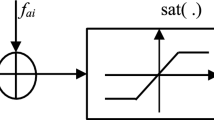Abstract
In this paper, we propose an output-feedback fault-tolerant controller (FTC) for a class of uncertain multi-input single-output systems under float and lock-in-place actuator faults. Of particular interest is to recover a fault-free tracking performance of a (pre-defined) nominal closed-loop system, during the entire time period including the transients due to abrupt actuator faults. As a key component, a highgain disturbance observer (DOB) is employed to rapidly compensate the lumped disturbance, a compressed expression of all the effect of actuator faults (as well as model uncertainty and disturbance) on the system. To implement this high-gain approach, a fixed control allocation (CA) law is presented in order to keep an extended system with a virtual scalar input to remain of minimum phase under any patterns of faults. It is shown via the singular perturbation theory that the proposed FTC, consisting of the high-gain DOB and the CA law, resolves the problem in an approximate but arbitrarily accurate sense. Simulations with the linearized lateral model of Boeing 747 are performed to verify the validity of the proposed FTC scheme.
Similar content being viewed by others
References
Belcastro C M, Groff L, Newman R L, et al. Preliminary analysis of aircraft loss of control accidents: worst case precursor combinations and temporal sequencing. In: Proceedings of AIAA Guidance, Navigation, and Control Conference, National Harbor, 2014. 1–32
Gorman S. Electricity grid in U.S. penetrated by spies. The Wall Street Journal, 2009. http://www.ismlab.usf.edu/isec/files/Electricity-Grid-Spied-04-09-WSJ.pdf
Zhang Y, Jiang J. Bibliographical review on reconfigurable fault-tolerant control systems. Annu Rev Control, 2008, 32: 229–252
Yu X, Jiang J. A survey of fault-tolerant controllers based on safety-related issues. Annu Rev Control, 2015, 39: 46–57
Li D Y, Li P, Cai W C, et al. Adaptive fault-tolerant control of wind turbines with guaranteed transient performance considering active power control of wind farms. IEEE Trans Ind Electron, 2018, 65: 3275–3285
Chakravarty A, Mahanta C. Actuator fault-tolerant control (FTC) design with post-fault transient improvement for application to aircraft control. Int J Robust Nonlinear Control. 2016, 26: 2049–2074
Bustan D, Sani S K H, Pariz N. Adaptive fault-tolerant spacecraft attitude control design with transient response control. IEEE/ASME Trans Mech, 2014, 19: 1404–1411
Ohishi K, Ohnishi K, Miyachi K. Torque-speed regulation of DC motor based on load torque estimation method. In: Proceedings of JIEE International Power Electronics Conference, Tokyo, 1983. 1209–1218
Chen W H, Yang J, Guo L, et al. Disturbance-observer-based control and related methods: an overview. IEEE Trans Ind Electron, 2016, 63: 1083–1095
Sariyildiz E, Ohnishi K. Stability and robustness of disturbance-observer-based motion control systems. IEEE Trans Ind Electron, 2015, 62: 414–422
Li S, Yang J, Chen W H, et al. Disturbance Observer-based Control: Methods and Applications. Boca Raton: CRC Press, 2014
Shim H, Park G, Joo Y, et al. Yet another tutorial of disturbance observer: robust stabilization and recovery of nominal performance. Control Theor Technol, 2016, 14: 237–249
Xu B, Yuan Y. Two performance enhanced control of flexible-link manipulator with system uncertainty and disturbances. Sci China Inf Sci, 2017, 60: 050202
Back J, Shim H. Adding robustness to nominal output-feedback controllers for uncertain nonlinear systems: a nonlinear version of disturbance observer. Automatica, 2008, 44: 2528–2537
Back J, Shim H. An inner-loop controller guaranteeing robust transient performance for uncertain MIMO nonlinear systems. IEEE Trans Autom Control, 2009, 54: 1601–1607
Johansen T A, Fossen T I. Control allocation — a survey. Automatica, 2013, 49: 1087–1103
Hoppensteadt F C. Singular perturbations on the infinite interval. Trans Am Math Soc, 1966, 123: 521–535
Kokotović P, Khalil H K, O’Reilly J. Singular Perturbation Methods in Control: Analysis and Design. Orlando: Academic Press, 1986
Bhattacharyya S P, Chapellat H, Keel L H. Robust Control: The Parametric Approach. Englewood Cliffs: Prentice Hall, 1995
Khalil H K. Nonlinear Systems. 3rd ed. Englewood Cliffs: Prentice Hall, 2002
Tao G, Chen S, Joshi S M. An adaptive actuator failure compensation controller using output feedback. IEEE Trans Autom Control, 2002, 47: 506–511
Gayaka S, Yao B. Accommodation of unknown actuator faults using output feedback-based adaptive robust control. Int J Adapt Control Signal Process, 2011, 25: 965–982
Acknowledgements
This work was partly supported by Institute for Information & Communications Technology Promotion (IITP) Grant Funded by the Korea Government (MSIP) (Grant No. 2014-0-00065, Resilient Cyber-Physical Systems Research), and partly by National Research Foundation of Korea (NRF) Grant Funded by the Korea Government (MSIP) (Grant No. 2015R1A2A2A01003878).
Author information
Authors and Affiliations
Corresponding author
Rights and permissions
About this article
Cite this article
Park, G., Shim, H. Guaranteeing almost fault-free tracking performance from transient to steady-state: a disturbance observer approach. Sci. China Inf. Sci. 61, 70224 (2018). https://doi.org/10.1007/s11432-017-9435-3
Received:
Revised:
Accepted:
Published:
DOI: https://doi.org/10.1007/s11432-017-9435-3




